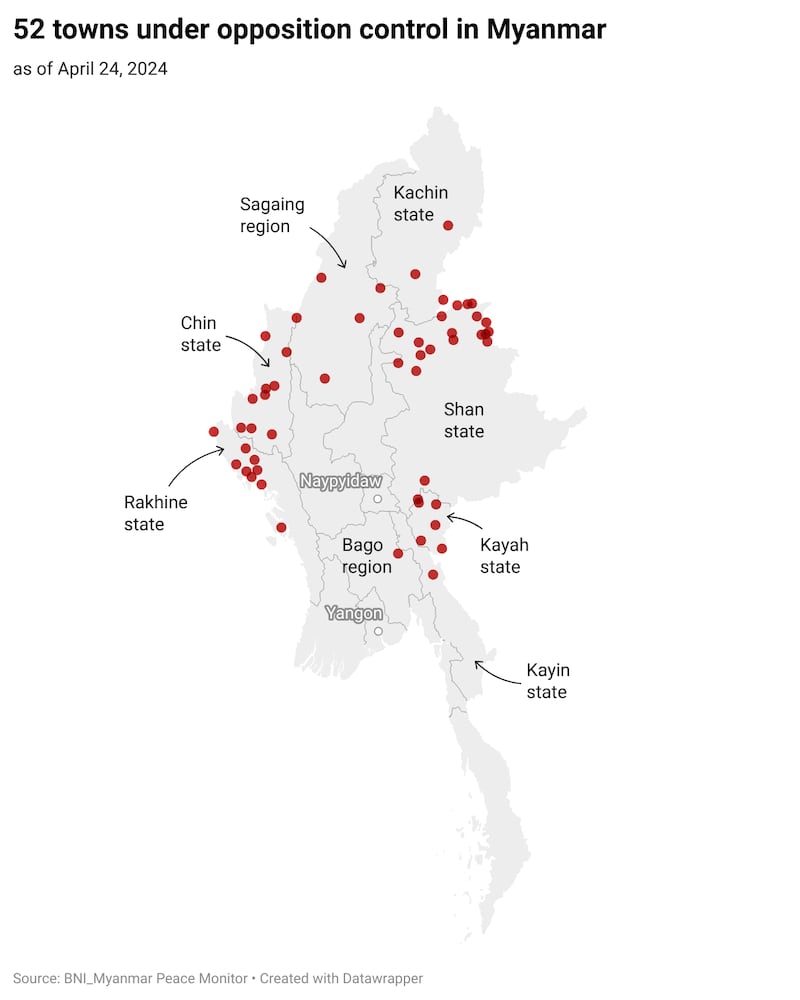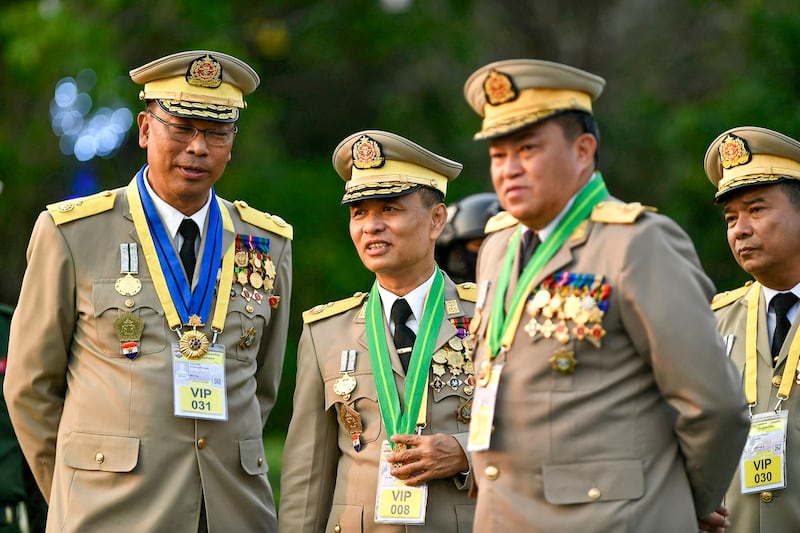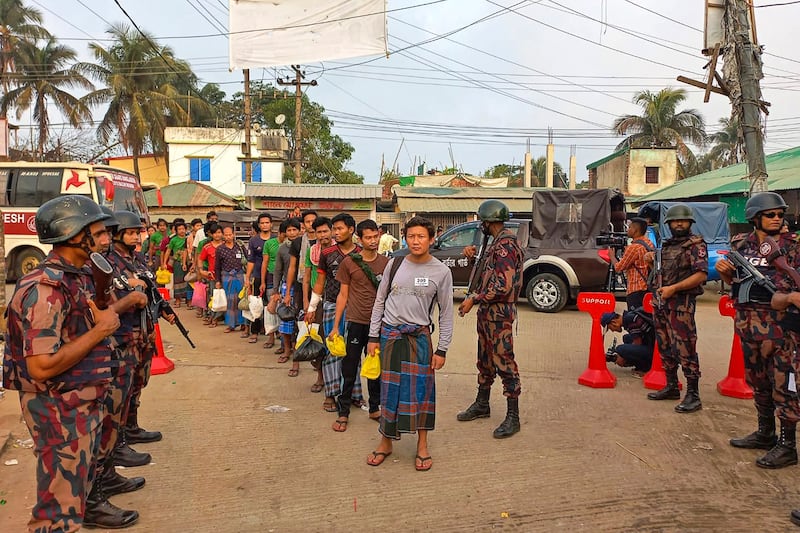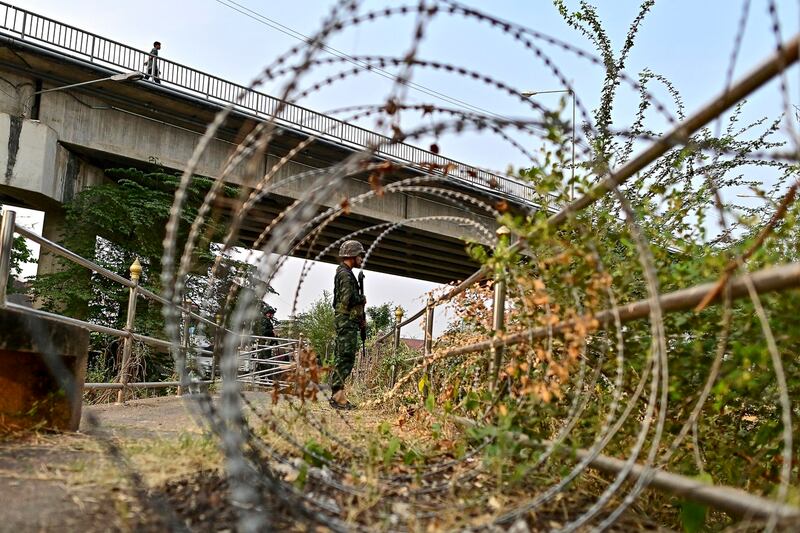Just over three years since Myanmar’s military seized control of the country in a February 2021 coup d’etat, the junta’s grip on power is increasingly tenuous amidst a nationwide civil war that has spiraled out of control.
What began as a military campaign to solidify rule in Myanmar’s remote border regions has devolved into a struggle of survival for the military as rebel forces become more united and more adapted to the conflict, and have dealt junta forces a series of battlefield defeats. Experts say the military regime’s prospects are now more grim than ever.
Zachary Abuza, a Southeast Asia analyst at the National War College in Washington – who writes commentaries regularly for Radio Free Asia – said Myanmar’s military leaders are “denying the harsh reality” of what they have reduced the country to.
“The economy has already collapsed,” he said. “Battles have been lost, and cities are engulfed in escalating violence. Drone attacks have breached the capital. The generals find themselves vexed by the relentless pressure from the shadow [National Unity Government] NUG and their allies.”
The military has lost townships to rebel forces across the country – most notably in Myanmar’s Kachin state along the northern border with China, Rakhine state on the western border with Bangladesh, and Kayin state on the eastern border with Thailand.

Troop shortages are dire and not even a hugely unpopular military draft expected to bring 50,000 new recruits by the end of the year can shore up their ranks, observers told RFA Burmese.
In Rakhine, the ethnic Arakan Army, or AA, has taken control of eight of the state’s 17 townships, as well as one township in neighboring Chin state, since it ended a ceasefire agreement with the military on Nov. 13, 2023. The junta has even turned to the forced recruitment of ethnic Rohingyas, long persecuted and denied citizenship in Myanmar, to bolster its fight against the rebels.
Miemie Winn Byrd, a retired U.S. Army lieutenant colonel who is active in Myanmar affairs, said the situation in Rakhine shows that the junta is on the ropes.
"During these next six months, any setback for the military will prove difficult to overcome,” she told RFA Burmese. “The passage of the conscription law highlighted a glaring reality: ‘Our ranks are thin.’”

Jason Tower, the country director for Myanmar at the U.S. Institute of Peace in Washington, DC, shared the view that the troop shortage has become an existential concern for the junta.
"The number of soldiers lost is much higher than the amount that can be replenished by the conscription law,” he said. “Since the newly arrived soldiers are forced to fight, they are more likely to surrender or desert the army once they reach the battlefield.”
Battle for Myawaddy
At stake for the junta in Kayin state is the town of Myawaddy, through which US$1 billion in trade flows annually across the border with Thailand’s Mae Sot. Joint anti-junta forces under the ethnic Karen National Liberation Army, or KNLA, have engaged in pitched battles with the military in recent weeks for control of the vital urban hub.
On April 10, the KNLA and its allies captured the junta's Infantry Battalion 275 compound in downtown Myawaddy. It was the last junta base in the town, which effectively fell under rebel control.
But last week, the military retook the base, while the KNLA has retained control of multiple military camps and bases in wider Myawaddy township.
Byrd noted that ethnic armies like the KNLA are increasingly collaborating with guerillas who make up the People’s Defense Force, or PDF – a loose coalition of local paramilitary groups, many of which have pledged allegiance to Myanmar’s shadow National Unity Government, or NUG, made up of lawmakers deposed by the coup.

Meanwhile, she said, ethnic armies that have ceasefires in place or were in talks with the military “are shifting their stance” as the conflict drags on.
“Now, they remain neutral observers, assessing the balance of power,” Byrd said. “Their allegiance will ultimately sway toward the victor. Their movement toward [the rebellion] serves as a promising sign: a tipping point indicating that revolution is within reach.”
Sai Kyi Zin Soe, a military and political commentator, noted that anti-junta forces made up of ethnic armies and local PDF groups appear to be focused on occupying as many of the country’s border areas as possible in a bid to control the flow of trade.
“In this endeavor, multiple organizations play pivotal roles,” he said, adding that the key to their success is in their ability to cooperate, despite their varied individual goals. “When they start fighting, they seem to keep a watchful eye on one another … Amidst this intricate web, vigilant monitoring and mutual control characterize the conflict dynamics.”
Rebel cooperation
In Kachin state, in the far north, the ethnic Kachin Independence Army, or KIA, launched an offensive against the military on March 7. In the more than a month of fighting, junta troops have steadily retreated from the region’s military camps. The ethnic army now controls more than 60 of them, according to KIA Information Officer Col. Naw Bu.
The KIA also controls the town of Lwegel, a significant trade center on the border with China, as well as other key border crossings and main highways.
In neighboring Shan state, to the south, the Three Brotherhood Alliance of ethnic armies has dealt the junta’s military forces a series of defeats since late last October. Their offensive has captured 32 towns and villages, including district-level townships.
Byrd called the Three Brotherhood Alliance offensive – known as Operation 1027, for its Oct. 27 launch date – a milestone for the rebellion, which she now believes has “gained the power balance.”
“The rebel side has improved in joint operations, and its intelligence gathering has also improved,” she said.
In particular, Byrd said that intelligence had dramatically upgraded the use of drones, which anti-junta forces have embraced as a low-cost method to level the playing field against military airstrikes and artillery.
“If the intelligence is no good, no matter how many drones there are, they are worthless when the targets have no value,” she said.

In Kayah state, the Karenni Army and its ethnic allies launched an offensive in November and have seized several townships, including Mese on the border with Thailand. The group claims to control 80% of the state capital, Loikaw.
Sai Kyi Zin Soe said that the varied Karenni groups have demonstrated an ability to effectively cooperate with one another, and use the military’s reluctance to conduct airstrikes and use heavy artillery near the border to their advantage.
The groups have formed administrative and legislative bodies, and introduced measures to promote law and order within their territories, he said.
"Under such circumstances, they prioritize rehabilitation, education, and healthcare,” he said. “This positive shift can be attributed to the different regional structure, the relatively small population, and the interconnectedness among existing groups."
War and governance
In Myanmar’s majority Burman Sagaing region, on the country’s northern border with India, the PDF has been engaged in pitched battles with the military in the townships of Kale, Kani, Mingin, Tedim, Kawlin, Pinlebu, and Tigyaing since early February. On Feb. 13, the military reclaimed Kawlin, which was the first township to be surrendered to the PDF in Sagaing.
While Sagaing is a stronghold of the rebellion, Sai Kyi Zin Soe said that friction between anti-junta forces in the region – particularly those who are not aligned with the NUG – has hamstrung their collective fight against the military.
“They kill each other, arrest [each other] and take other actions [independently], so you can see that there is confusion on the ground,” he said.
Sai Kyi Zin Soe said that the groups need to develop administrative systems and build political power, in addition to fighting the junta.
“Armed struggle is about the least damage and most protection to the public, only then will the public be able to understand and accept the armed revolution,” he said. “If you can't create something like that, the situation can't be good.”
In the meantime, experts said, the military has largely maintained its grip on power in the central Myanmar regions of Sagaing, Magwe and Mandalay – all bastions of the Burman majority – and in major cities.
But they questioned whether that would last, given what they said is the junta’s inability to lead, both militarily and politically.

A retired officer from Myanmar’s military, who spoke on condition of anonymity due to security concerns, put the junta’s failure to win on the battlefield squarely on the shoulders of its chief Senior Gen. Min Aung Hlaing and his generals.
“Critical issues that needed addressing, such as troop placement, have remained unattended. Furthermore, there seems to be a lack of strategic movement and defense,” he said. “I have never seen this kind of [poor] management … in the history of our military."
As the situation becomes increasingly desperate for the junta, the National War College’s Abuza said its leaders find themselves “unwittingly drawn into senseless actions.”
“Amidst this turmoil, perhaps the most significant victory [for the rebellion] lies in the chaos itself.”
Translated by Kalyar Lwin. Edited by Joshua Lipes and Malcolm Foster.
